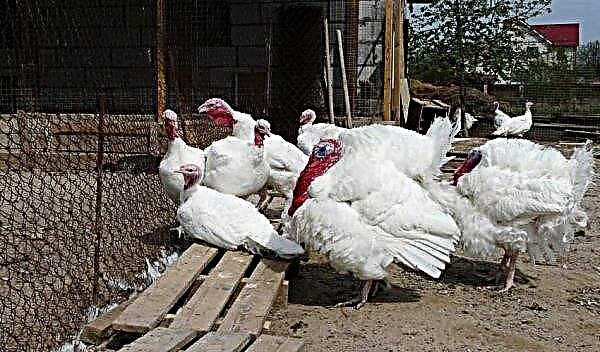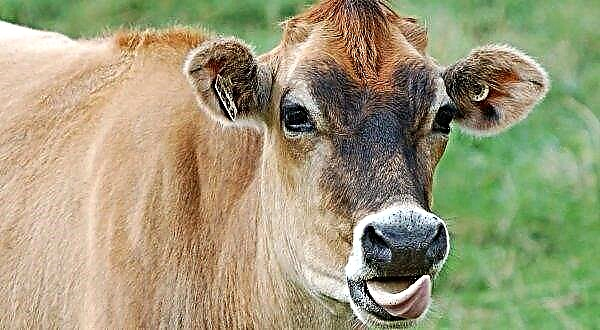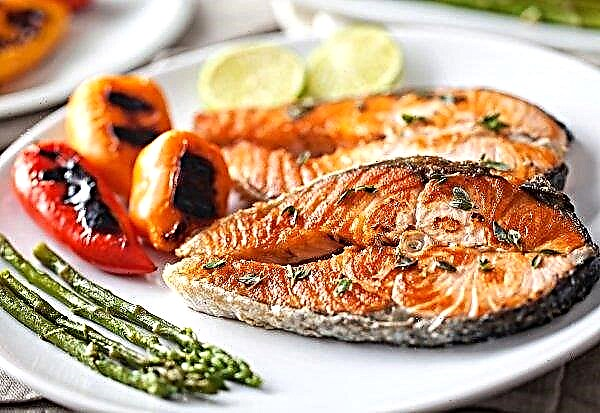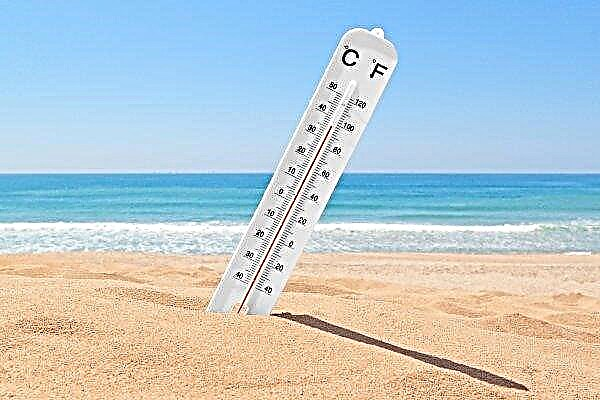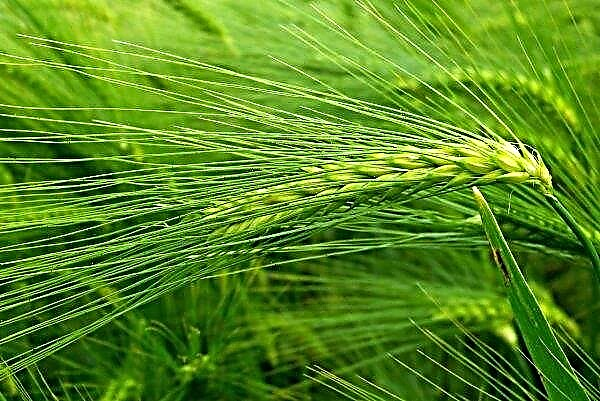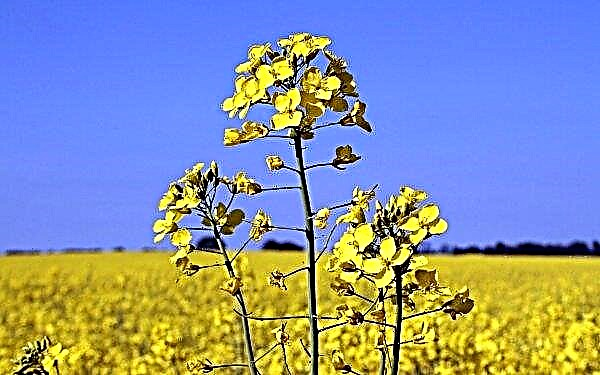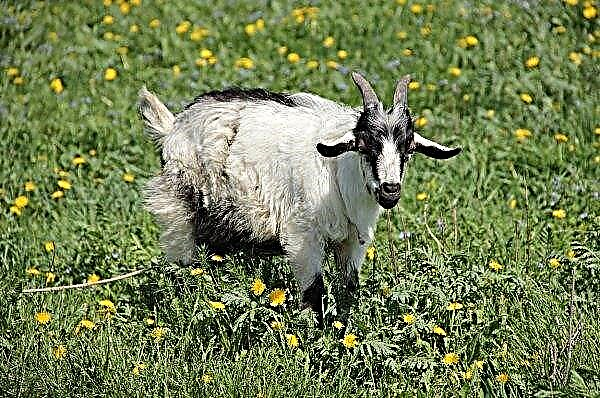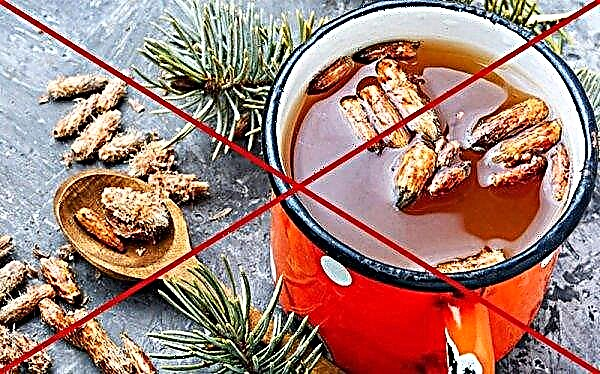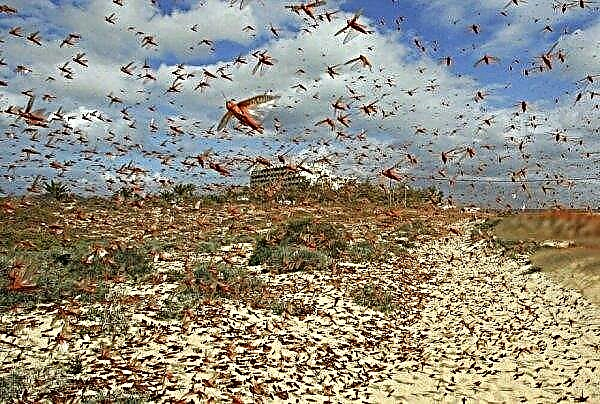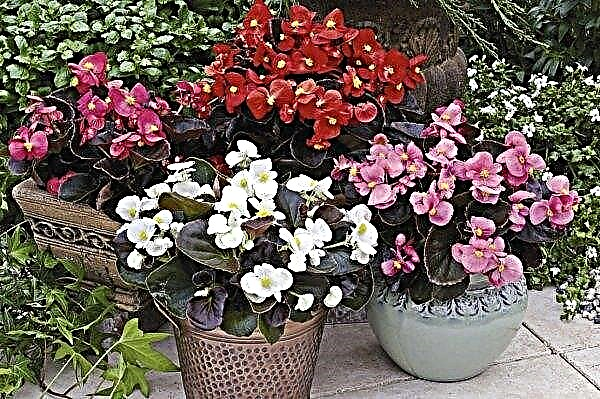Each breeder knows how many valuable substances are contained in cabbage and how useful it is to add it to the diet of their “wards”. However, the usual varieties of this vegetable are too expensive to use for this purpose, especially if it is not about small-scale household plots, but about a serious agricultural holding. An excellent way out of the situation is to grow a special feed of cabbage - the culture in our country is little known, but gaining more and more popularity, and therefore worthy of a separate review.
General description of the culture
The Latin name of the plant is Brassica subspontanea Lizg. It belongs to the Cabbage family, has a two-year life cycle. Cultivation of the culture requires certain costs, however, as practice shows, they repeatedly pay off.
Did you know? The largest cabbage in the world was able to grow a farmer from Alaska named John Evans. The weight of his "brainchild" was 34.4 kg and was awarded the entry in the Guinness Book of Records.
In particular, the fact that it:
- much more unpretentious than other varieties of cabbage;
- suitable for feeding almost all types of farm animals and birds;
- completely used in food (both the stem and leaves);
- gaining large sizes;
- cattle really like;
- increases milk production when cows and goats are included in the diet, as well as egg production when feeding laying hens;
- It has a very high nutritional value, ahead of any root vegetables in this indicator and practically not inferior to oatmeal;
- contains a large number of nutrients necessary for increasing livestock productivity (sugar, fiber, vitamins A, B, C, minerals, easily digestible proteins, etc.);
- it is well silted and stored for a long time, in addition, it can be used fresh even after freezing;
- has a wide zoning zone, suitable for widespread cultivation;
- differs in excellent frost resistance (can tolerate frosts to -14 ° C);
- yields very good yields: average values are 300-350 kg with 100 m², but there are also records when 800 kg of crops can be collected from the same area (it should be noted that some varieties of white cabbage produce much higher yields, but the cost of it growing immeasurably higher).
 Plants containing mustard oils have another drawback: these substances are able to penetrate into milk and give it an unpleasant bitter taste. In order to achieve stimulation of lactation and at the same time to prevent deterioration in the quality of milk, the daily dose of fodder cabbage in the diet of cows should be 15–25 kg, that is, no more than ¼ of the total mass of green feed.
Plants containing mustard oils have another drawback: these substances are able to penetrate into milk and give it an unpleasant bitter taste. In order to achieve stimulation of lactation and at the same time to prevent deterioration in the quality of milk, the daily dose of fodder cabbage in the diet of cows should be 15–25 kg, that is, no more than ¼ of the total mass of green feed.Important! The composition of fodder cabbage contains a small amount of mustard oils, which irritate the mucous membranes and cause endocrine disruption in humans and animals; therefore, the plant must be strictly dosed in animals.
Characteristics of flowering and fruit
Brassica subspontanea is a tall plant consisting of an upright cylindrical (first year of life) or spindle-shaped (second year of life) stem 1.5–2 m long and 3–5 thick, sometimes up to 10 cm, and also large, from 50 to 80 cm in length and from 30 to 40 cm in width, smooth leaves covered, like the stem, with a waxy coating. Their shape can be different - ovoid, lyre-shaped or lanceolate, flat or curly. Depending on the variety and variety, the color of the leaves is different - from green to purple with all possible intermediate options.
Leaves are not collected in a head, they are attached to the stem by cuttings, longer (up to 40 cm) in the lower part of the plant and short (up to 15 cm) in the upper one. Despite the fact that the stalk of the cabbage is rather coarse, the middle of it is very juicy, therefore the so-called stems are used in food by animals along with leaves. If the soil where the forage cabbage grows is moist enough, several additional branches can grow from a single stem of the plant. In the second year of the biological cycle, Brassica subspontanea forms peduncles that appear in the axils of the leaves. Outwardly, they look like long, from 120 to 160 cm, weakly leafy and branched shoots. The plant belongs to the cross-pollinated, that is, male and female flowers are formed on different individuals. The inflorescence itself is a loose brush 50–80 cm long, consisting of numerous flowers of white or light yellow color up to 5 cm in size. After pollination, the fruit is formed in the form of a smooth pod up to 10 cm long, having the shape of a cylinder, inside of which there are up to a thousand small seed. The weight of each seed does not exceed 6 g, it has a round shape, the surface is smooth and shiny. The color of the seeds can vary from gray or gray to black.
The plant belongs to the cross-pollinated, that is, male and female flowers are formed on different individuals. The inflorescence itself is a loose brush 50–80 cm long, consisting of numerous flowers of white or light yellow color up to 5 cm in size. After pollination, the fruit is formed in the form of a smooth pod up to 10 cm long, having the shape of a cylinder, inside of which there are up to a thousand small seed. The weight of each seed does not exceed 6 g, it has a round shape, the surface is smooth and shiny. The color of the seeds can vary from gray or gray to black.
Feed zone
The birthplace of the plant is the territory of the Mediterranean, or rather, its eastern part. Europeans have long and successfully cultivated this crop; it is also popular on both continents of America, in Africa, Australia, Asia and Polynesia (New Zealand). Traditionally, cultivation of Brassica subspontanea is most common in coastal areas.
Did you know? Growing animals for food is a very dirty activity. Scientists have calculated that the waste from this process is 130 times greater than the waste from the life of all people in the world.
Historically, forage cabbage, growing in different regions of the world, has some morphological differences, in connection with which it is customary to distinguish two of its main species, each of which has its own distribution zone:
- Ancient West European variety originally from Italy. Latin name Brassica oleracea L. var. ramosa DC. It features very curly leaves. Sometimes called plume. This species is usually cultivated in South Asia, Africa and in the west of France.

- Cultivated variety Brassica oleracea f. silvestris L. Originally from England, Atlantic Europe and the Mediterranean. It is grown almost everywhere in Western Europe, it is very popular in the suburban areas of Asia Minor, it is also cultivated in the USA, Australia, Japan, on the Cape Verde islands, sometimes in the tropical regions of Asia, and the Caucasus. The English call this culture green sprouts or kale, the Germans call blattkohl, winterkohl or grünkohl, the French know it as choux vert. In Russia and on the territory of other countries of the former USSR, it is mainly this variant that is known here that is known as the “Siberian” variety (the first variety in Russia is called the “Scottish” variety).
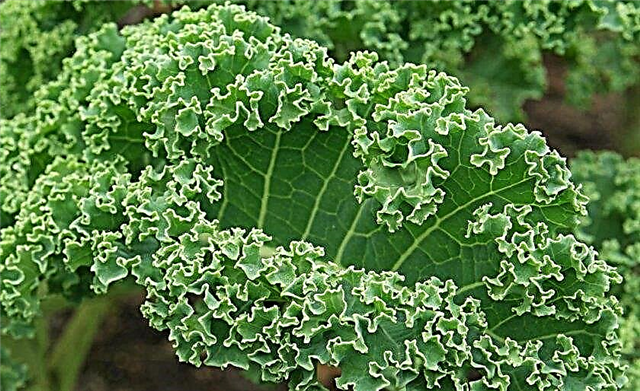
A vivid proof of this is the almost unlimited zone of its distribution. It is enough to note that, for example, in Russia fodder cabbage is grown everywhere today - from the harsh regions of the Arctic to the hot subtropics, not to mention the agriculturally favorable territory of the Central Black Earth region.
The most popular varieties of forage cabbage
Today, farmers know a huge number of varieties and hybrids of forage cabbage, but the following are most suitable for cultivation in the middle lane of the European part of Russia and other areas with a continental climate:
- Brain Green. The bush is highly leafy, while the stems are purple in color, and the leaves are purple-greenish. It is resistant to pests and does not tolerate drought.
- Brain green sivers. Received due to the improvement of the previous variety by the efforts of breeders from St. Petersburg. It has green and large wrinkled oval leaves on long petioles, the stem is thick, without branching. Distinctive features are very large sizes and the absence of shoots on the side buds. Productivity is high, but among the disadvantages there is instability to sclerotia and bacteriosis. Stored better than Brain Green.
- Thousand-headed (sometimes called Yarrow). As the name implies, it has a very strong foliage, branches well, but the leaves themselves are not very large, have an oval shape and curly structure. The color of the leaves is light green. Resistance to bacteriosis is average.
- Milestone. Great for small farms, as it is easy to care for and does not require the use of serious equipment. Differs in very high productivity and the short vegetative period. The foliage is high, the leaves are lyre-shaped, saturated green.
- Wma. It differs by not very high requirements for lighting, drought tolerance and especially high productivity (up to 1 ton from 100 m² and higher). By frost resistance is not inferior to other varieties. The foliage is medium, bushiness is high, the color of the leaves is light green.
 a - thousand-headed; b-brain green Siverskaya. In addition to the above varieties, Brain green Vologda, Brain blue, Brain red, Moscow Region, Polyarnaya, as well as hybrids - Redbor F1 with beautiful burgundy leaves and curly Reflex F1 are quite popular.
a - thousand-headed; b-brain green Siverskaya. In addition to the above varieties, Brain green Vologda, Brain blue, Brain red, Moscow Region, Polyarnaya, as well as hybrids - Redbor F1 with beautiful burgundy leaves and curly Reflex F1 are quite popular.Growing cabbage
As was said, forage cabbage is a two-year plant. Its growing season lasts from 140 to 160 days during the first year of life and from 80 to 90 days in the next year. In the dry period, the development of culture slows down, and with the onset of autumn cooling, when the daytime temperature drops to + 17 ... + 20 ° C, cabbage growth resumes with renewed vigor. During this period, the volume of green mass per day can increase up to 15 kg and even more by 10 m².
At the same time, neither summer drought, nor autumn frosts are dangerous for adult plants, cabbage can recover even with a short-term decrease in temperature to -15 ° C, which is not characteristic of any of the common forage crops. After the subsequent warming (provided that the weather change did not pass abruptly), the frozen leaves gradually thaw, while maintaining both color and density. This amazing feature of Brassica subspontanea allows farmers to give animals fresh green food 1.5–2 months longer than usual and bringing its duration to 240–250 days a year. High cold resistance of forage cabbage both in its young and mature state allows to grow this culture both through seedlings and by direct sowing in open ground.
This amazing feature of Brassica subspontanea allows farmers to give animals fresh green food 1.5–2 months longer than usual and bringing its duration to 240–250 days a year. High cold resistance of forage cabbage both in its young and mature state allows to grow this culture both through seedlings and by direct sowing in open ground.
In a reckless way
Cold-resistant feed cabbage can be sown when the average daily temperature is +2 ... + 4 ° С, and even if short-term frosts occur after emergence, there is nothing to worry about: young sprouts can tolerate a cold snap of -6 ° С. The seeds are laid to a depth of 2-3 cm, the distance between the rows is from 60 to 70 cm, the density of sowing is 15–40 kg per 100 m².
Before sowing, seeds are recommended to be mixed with superphosphate sifted through a fine sieve in a ratio of 1:10. This will provide the plant with nutrition and allow the seed to stay at a given depth. After 3-4 real leaflets are formed on the seedlings, the crops are thinned to the standard pattern (between two adjacent plants there should be from 20 to 40 cm of free space).
Did you know? One of the most beautiful plants in the world is deservedly considered Romanesco cabbage. In form, it is a so-called fractal - a set that reproduces itself: a head of cabbage consists of flowers, each of which is of the same, but smaller, and so on for several steps.
It should be noted that specialists from the North-West Research Institute of Economics and Organization of Agriculture (St. Petersburg) developed a special method for growing forage cabbage, in which seedlings no longer thin out after sowing according to the standard scheme. However, to obtain high yields in this case, the soil is pre-treated with a large dose of strong herbicides, so its environmental safety is very doubtful.
Seedling method
The seedling method is considered more economical because it allows to reduce seed loss by about 60%. In addition, caring for such a crop after planting it in open ground is much simpler than what young shoots require. The advantage should be a larger set of green mass due to an increase in the growing season, however, as experience shows, in reality, the yield indicators for seedling and seedlings for growing fodder cabbage are approximately the same. At the same time, the preliminary cultivation of seedlings is a laborious process, and therefore, because of the high cost of production, large agricultural holdings are usually not used.
Important! The time of formation of seedlings of forage cabbage (from sowing to transplanting into the ground) is 35–40 days. The difference between the calendar terms of planting in open ground with seedling and seedling methods is only two weeks.
The preparation of seeds for planting with seedling and seedling method is identical. After 4–5 true leaflets have formed in seedlings, the seedlings are hardened and then transplanted into the open ground. Usually this procedure is carried out from mid-April to the end of June, depending on climatic conditions (the soil should warm up sufficiently, but at the same time remain sufficiently moist). For transplanting, you need to choose the most cloudy day, it is desirable that the same weather lasts for some more time until the seedlings take root.
There are several possible planting schemes (in cm):
- 70×20;
- 70×25;
- 70×30;
- 60×60;
- 60×40.
The last two options involve planting cabbage in two copies in each hole. It must be borne in mind that with too high a thickening, cabbage develops slowly, as a result, the set of green mass decreases, and, therefore, it will not be possible to achieve a higher yield per unit area.
Outdoor cabbage care
Care for planting fodder cabbage is not a big deal and comes down to ensuring regular watering, monitoring the condition of the soil, applying fertilizers, preventing pests and diseases, and, if necessary, garter tall plants.
Watering
Brassica subspontanea is a very hygrophilous plant. Moreover, the achievement of the declared indicators of high productivity is possible only with very abundant watering.
Important! The most active set of green mass in forage cabbage occurs in late summer and autumn, when the rainy season begins. This feature of the plant largely compensates for the high demands placed on it by frequent watering.
At the same time, this culture suffers greatly if water stagnates in its roots, and therefore it needs to be watered in such a way that moisture is immediately absorbed into the soil (the root system of the forage cabbage is quite powerful and goes to a great depth, so the plant is completely can cope with short surface drought). To ensure this result, good drainage is required, as well as a deep flow of groundwater. For the same reasons, heavy soil or lowland areas are not suitable for growing crops. 
Feeding
Before planting cabbage, the soil needs to be well fertilized with organic, while during the growing season, the main emphasis is usually on nitrogen fertilizers.During the season, it is recommended to carry out two dressings.
Recommended composition per 1 m²:
- ammonium nitrate - 10-15 g;
- nitrophoska - 30–40 g;
- superphosphate - 30 g.
Soil loosening
Loosening the soil after each irrigation and heavy rain is a mandatory procedure, since it ensures the saturation of the soil with oxygen and does not allow moisture to evaporate quickly. These conditions provide faster growth of cabbage. In addition, at the same time as loosening, it is very convenient to get rid of weeds, which not only take life sap from the crop, but also are the “reserves” of a large number of diseases and pests.
Pest and Disease Control
Brassica subspontanea is a unpretentious and hardy culture, therefore, with the proper care of the disease, it is not so often affected. If a similar problem does occur, it is almost always associated with a violation of agricultural technology. So, forage cabbage is often sick on acidic soils, with waterlogging, and also if the balance between humidity and temperature conditions is disturbed (traditionally, the colder the air, the more rare watering should be).
Among the most characteristic diseases of the culture should be called:
- Kilu
- rot - gray, white and dry;
- Alternariosis.
To combat cabbage diseases fungicidal preparations are used, such as, for example, Cumulus (effective against keel), Iskra (from alternariosis) and others.  A safer and more modern method of solving the problem is the use of biological agents, the most famous of which is Fitosporin. The powder should be diluted in a ratio of 5 g per 10 l of water and used for root and foliar treatment.
A safer and more modern method of solving the problem is the use of biological agents, the most famous of which is Fitosporin. The powder should be diluted in a ratio of 5 g per 10 l of water and used for root and foliar treatment.
Did you know? About 80% of the water consumed in the world goes to livestock. The total area used by people for the same purpose is about 70% of land.
If diseases for fodder cabbage are not a very frequent phenomenon, then a variety of harmful insects attack this nutritious crop with great desire. Such a problem should not be ignored, since plants affected by pests lose their growth power and may even die, and, in addition, their use for feeding livestock is also fraught with negative consequences: animals can refuse such food or get poisoned. Below are the most common cabbage parasites and drugs used to control them:
| Pest name | Way to fight |
| Cabbage Moth | Foliar treatment with Lepidocide |
| Cabbage White | Foliar treatment by Kinmiks or Fitoverm |
| Rapeseed Blossom | Foliar treatment "Ethaphos" |
| Cabbage fly | Foliar treatment "Karbofos", "Topaz" or "Iskra" |
| Cruciferous fleas | Dry pollination with tobacco dust and wood ash mixed in equal parts |
 1 - cabbage fly; 2 - cabbage whitewash; 3 - cabbage moth.
1 - cabbage fly; 2 - cabbage whitewash; 3 - cabbage moth.Harvest Features
Harvesting fodder cabbage should be done as late as possible, because this is the point of growing this crop. A sign that the vegetation cycle of Brassica subspontanea is completely completed, and it is useless to leave it in the ground, is the beginning of yellowing of the leaves in the lower part of the bush. Usually, by the time of harvesting, no other plants are left in the fields, and the first frosts are long behind. For example, for Ukraine this period may come at the end of November, and if the autumn turned out to be warm, even later.
There are two ways to give fodder cabbage to animals - fresh or as part of a silo. In the first case, the crop is simply stacked in a cellar or basement, and there are no strict temperature restrictions for storing stocks: with periodic ventilation, the crop can be stored until February. Often, cabbage stocks are stored in piles directly in the open, covering with snow if necessary.Important! Even in the case of complete freezing, the plant does not lose its nutritional value, however, before laying it in the feeders, it must first be thawed.
In case of silage, the cabbage is crushed, mixed with other components and laid for ripening. Brassica subspontanea makes an excellent silage supplement, as there is a lot of sugar in the culture (in this indicator it is second only to sorghum), which is an excellent preservative. Cabbage is a real find for livestock farmers, since it allows you to extend the period of use of fresh green feed in the diet of animals until the end of winter. The plant can be fed to all types of livestock and poultry, which can significantly increase their productivity, including egg production and milk yield. And given that it is possible to grow this crop under any climatic conditions and this process is not difficult, it is not surprising that it is gaining more and more popularity.
The plant can be fed to all types of livestock and poultry, which can significantly increase their productivity, including egg production and milk yield. And given that it is possible to grow this crop under any climatic conditions and this process is not difficult, it is not surprising that it is gaining more and more popularity.



